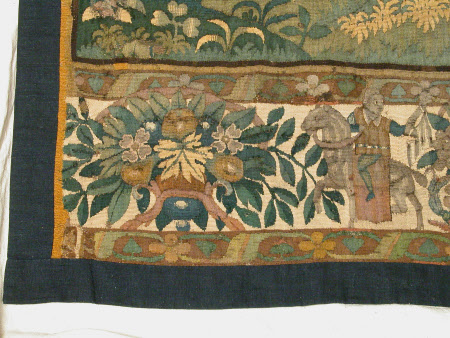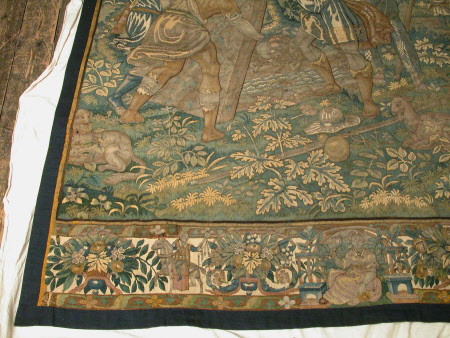The Meeting of Jacob and Rachel
Flemish
Category
Tapestries
Date
circa 1550 - circa 1600
Materials
Tapestry, wool and silk, 5 warps per cm
Measurements
270 x 410 mm
Order this imageCollection
Powis Castle and Garden, Powys
NT 1181017
Summary
Tapestry, wool and silk, 5 warps per cm, The Meeting of Jacob and Rachel from a set of five of The Story of Jacob, Southern Netherlands, c. 1550-1600. A landscape with two principal figure groups in the foreground and smaller figure groups in the background. In the foreground on the left Jacob, wearing a yellow cloak decorated with stars, and three shepherds, struggle to remove a large stone from the mouth of a well, allowing a flock of sheep to drink the water. On the ground in the left foreground are a shepherd’s crook, a hat and a flask, with a pair of goats and a dog sitting nearby. To the right Jacob appears again, approaching Rachel to kiss her. Both Jacob and Rachel hold shepherds’ crooks and Rachel is accompanied by a flock of sheep. In the background are two further small narrative scenes. In the centre two shepherds and a shepherdess approach the well with flocks, and behind them is a palace by a river with a wooden bridge. At the top right Jacob and Rachel appear again, arriving at the house of Laban, Rachel’s father, who embraces Jacob whilst his wife watches, and a cowherd grazes his flock by the gate of the farmstead. The background is taken up with hills covered in stylized foliage. There are no side borders and the upper and lower borders are composed of vases of fruit and flowers alternating with small figures including two men on horseback, and two small roundels containing a figure of Prudence holding a snake and a mirror, and Meleager offering the head of the Caledonian Boar to Atalanta.
Full description
This is the first tapestry in the 'Story of Jacob' set at Powis. After Jacob deceived his aged father Isaac to receive the blessing meant for his older twin brother Esau, Esau became enraged and swore to kill Jacob. Their mother, Rebecca, heard of Esau’s angry words and in order to protect Jacob she arranged for him to be sent away to the land of her brother, Laban, to find a wife (Genesis 27:1-46). When Jacob arrived at the land of Padan-Aram where Laban lived he found a well with three flocks of sheep by it, and saw men rolling back a stone from the mouth of the well so that the sheep could drink. He spoke to the men and asked whether they knew Laban, whereupon they told him that Laban’s daughter, Rachel, was approaching with her father’s sheep. Jacob was told that Rachel could not water the sheep, and would have to wait until all the flocks were gathered together and the stone was rolled from the mouth of the well. Jacob spoke to Rachel, and then he rolled back the stone from the well so that the sheep of Laban, his mother’s brother, could drink. This is the scene on the left hand side of the tapestry. Next “Jacob kissed Rachel, and lifted up his voice, and wept” (Genesis 29:11), and told her who he was. This is the scene on the right hand side. Rachel then took Jacob to her father’s house, and Laban ran out to meet him; we see the two men embracing in the background at the upper right. All the scenes in the tapestry are based on Genesis chapter 29. Jacob and his twin brother Esau were born when their parents were entering old age, having been married for twenty years. Esau was the first twin to emerge, and was hairy all over; Jacob emerged second, holding on to his brother’s heel. Esau grew up to be a hunter, but Jacob was a quiet man. Jacob bought Esau’s birthright (the right to be considered the firstborn) for a mess of pottage, and with the help of their mother Rebecca he deceived their ageing and blind father into giving him the blessing that was meant for Esau by dressing himself in goats’ skins to imitate Esau’s hairy arms. Esau was angry and resolved to kill his brother, so Rebecca arranged for Jacob to be sent away in search of a wife to the land of her brother Laban. The first tapestry in the series at Powis shows Jacob meeting Rachel, the daughter of Laban, for the first time. After serving Laban for twenty years and being deceived by him many times, Jacob finally left secretly, taking his four wives and twelve sons with him; the second tapestry shows Laban catching up with Jacob, and also Jacob meeting his brother Esau again. The third tapestry shows the rape of Dinah, Jacob’s daughter, by Shechem, an event which was followed by a bloody revenge meted out by Jacob’s sons Simeon and Levi. Jacob’s second youngest son, Joseph, was to be the next patriarch and ruler of his brethren. As a young man Joseph was sold by his brothers into Egypt, and there he rose to a position of great power; the last two tapestries are set in Egypt, where finally Jacob and the rest of his sons joined Joseph. Jacob can be recognised in each tapestry as he wears a cloak decorated with stars, in reference to Genesis 26:4, where God appeared to Isaac and said “And I will make thy seed multiply as the stars of heaven, and will give unto thy seed all these countries; and in thy seed shall all the nations of the earth be blessed.” Jacob’s twelve sons were the originators of the twelve tribes of Israel. No makers’ marks are visible on any of the Jacob tapestries (although they may be present underneath the applied edging on some of the panels). John Böttiger suggested that a related series in a Swedish private collection may have been made in the Northern Netherlands (present-day Holland) by weavers who had emigrated from the tapestry-producing lands of the Southern Netherlands in the second half of the sixteenth century. However there is nothing to suggest that this is the case, and the set was almost certainly produced at one of the weaving centres in the Southern Netherlands (roughly present-day Belgium) such as Antwerp or Oudenaarde. Böttiger dated the Swedish series to the second half if the sixteenth century and the set at Powis can be dated to the same period. A set of five tapestries after the same designs was originally in the Swedish Royal Collection at the Castle of Kungsör. The set was sold in 1892 and by 1928 one of the tapestries had disappeared, and the other four were in three separate private collections in Sweden (Böttiger 1928, pp. 35-40). The subject of the first of the Swedish tapestries, ‘Jacob gathering his Wives before Fleeing the Land of Canaan’, does not appear in the Powis set, but the other three do: ‘Laban Searching for the Idols and the Meeting of Jacob and Esau’, ‘Jacob before Pharaoh’, and ‘The Meeting of Joseph and Jacob in Egypt’. The borders of the Swedish set have a similar overall structure to the Powis set with figures and scenes arranged between bunches of flowers, but some of the figures are different, the side borders are wider, and each tapestry has a cartouche in the upper border with a long inscription describing the scene. It is possible that the series as a whole included further scenes: the important events of Jacob’s early life, including Esau selling his birthright, and Jacob stealing Esau’s blessing, appear in many other sixteenth-century tapestry sets of the ‘Story of Jacob’. The tapestries cannot be definitely identified in the 1891 inventory of Powis, but in 1908 three from the set were in their current positions in the Duke’s Room (then ‘Her Ladyship’s Sitting Room’) described as “A King seated under a canopy on Audience” (‘Jacob before Pharaoh’), “The Meeting of Jacob and Esau” (‘The Meeting of Joseph and Jacob’), and “The capture of a city and its women” (‘The Rape of Dinah’) (Knight, Frank & Rutley 1908, pp. 52-53). A description of the Duke’s Room in 1917 indicates that the tapestries were originally at Lymore, and describes them in enthusiastic terms: “the rest of the wall space [in Lady Powis’s Sitting Room – formerly the Duke’s Room] is taken up by an oak chimneypiece, by two doorways, and by a set of three sixteenth century tapestries from Lymore, the ancient home of the Herberts of Chirbury. The manner of the doorways and wall hangings is excellently shown in the illustration […], and therefore needs no further description beyond saying that much of the charm of the tapestries arises from their colouring. They were in a cut and ravelled condition, but have been perfectly repaired and are but a little faded. The general tone is blue green, that being the colour of most of the trees and landscape. This harmonises perfectly with the full indigo of some of the clothing of the figures and the green grass of some of the foliage, but in the photography the latter stands out too distinctly as dark, while the former is too pale and imperceptible” (Avray Tipping 1917, p. 139). The 1930 Powis inventory records the three tapestries in the Duke’s Room with the same titles as in 1908, and values them collectively at £350, whilst two further tapestries described as “The Parting of Abraham and Lot” (£200) and “The Meeting of Jacob and Esau” (£150) were in the Gateway Room (Supplementary Inventory 1930, pp. 1, 3). (Helen Wyld, 2010)
Provenance
Formerly at Lymore; brought to Powis Castle before 1908; accepted by HM Treasury in lieu of tax on 21 March 1963 and conveyed to National Trust ownership in 1992.
Credit line
Powis Castle, The Powis Collection (The National Trust)
Makers and roles
Flemish, workshop
References
Clive, 1930: Viscount Clive Decd. Items recommended for exemption under section 40 of the Finance act 1930, 1930 Böttiger, 1928: Johann Böttiger, Tapisseries à figures des XVIe et XVIIe siècles appartenant à des collections privées de la Suède : inventaire descriptif, 2 vols., Stockholm 1928 H Avray Tipping, ‘Powis Castle – II’, Country Life, 10 February 1917, pp. 132-9 Knight, Frank and Rutley, 1908: Messrs. Knight, Frank and Rutley, An Inventory of the Furniture and Effects at Powis Castle Welshpool, Wales. The Property of the Right Honourable the Earl of Powis. March 1908





